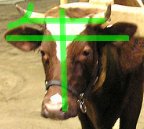Again, Furthermore
This kanji is a picture of a right arm holding something (a long thing such as a firewood) on the shoulder. Carrying things on the shoulder lets us carry more weight, or for a further distance, especially when the weight is evenly distributed across both shoulders such as in the Fireman's Carry, the position of which resembles the shape of this kanji.
- 又は (または) Or, Otherwise
毛 (モウ、け)
Fur, Hair
 |
| By decade_resister (Flickr) CC BY-NS-SA 2.0 |
- 不毛 (ふもう) Sterile, Barren, Unproductive
友 (ユウ、とも)
Friend
Consists of the kanjl for "again/furthermore" (又) and the radical ノ and 一. The radical ノ and 一 represent a shoulder and an arm. Altogether, they represent someone who gives us his / her hands (help) and shoulders (a place to lean on) more than other people do, again and again.
- 友人 (ゆうじん) Friend
- 友好 (ゆうこう) Friendship
反 (ハン、ホン、タン、そ.る、かえ.る)
Anti-, Return, Warp
Consists of the "cliff" radical (厂) and the kanji for "again/ furthermore" (又). Most cliffs are formed due to erosion, and in the case of coastal cliffs, erosion by sea waves. Further erosion will create a curve at the bottom, and the cliff will appear to be bent / arched if seen from the side. When this curve gets bigger and bigger, the upper part of the cliff will lose its supporting structure, and the cliff will collapse. The notion of "anti-" and "return" came from the fact that when we try to bend something (especially long objects), we are actually trying to make the ending point "returns" to the starting point (the opposite point).
公 (コウ、ク、おおやけ)
Public
The upper part of this kanji represents something being split, while the lower part is the "myself" radical (厶) which has the same shape as the katakana "mu". Together they represent the meaning of splitting/sharing one's individuality/privacy with others, hence the meaning of "public".
- 公平 (こうへい); 公正 (こうせい) Fairness, Impartial, Justice
- 公立 (こうりつ) Public (institution)












 ) and the gas/vapor radical (气) to represent water vapor (steam).
) and the gas/vapor radical (气) to represent water vapor (steam).






 ), a horizontal line (一), the kanji for "earth" (土), and two additional dots. Notice that this kanji have some similarities to the "jade" kanji (玉) presented in lesson 5. The horizontal line represents the sky, and joined with earth (土) makes a "king" kanji (王). The two dots represent gold pieces. Golds are usually found buried under the earth, but their value is sky high. And as golds are commonly used as money in ancient times, their possession and distribution is ruled by the king, and of course, the king has the most gold. As for the roof radical, in ancient china, only the imperial palace may have a golden / yellow roof, as can be seen today in The Forbidden City. Notice that "gold" (金) have two dots while "jade" (玉) have only one dot. This can be seen as an implication of the Chinese saying mentioned in lesson 5: "Gold have a price, but Jade is priceless". The one dot vs. two dots can be seen as the "first place" vs. "second place", or the "rarest" vs. "less rare".
), a horizontal line (一), the kanji for "earth" (土), and two additional dots. Notice that this kanji have some similarities to the "jade" kanji (玉) presented in lesson 5. The horizontal line represents the sky, and joined with earth (土) makes a "king" kanji (王). The two dots represent gold pieces. Golds are usually found buried under the earth, but their value is sky high. And as golds are commonly used as money in ancient times, their possession and distribution is ruled by the king, and of course, the king has the most gold. As for the roof radical, in ancient china, only the imperial palace may have a golden / yellow roof, as can be seen today in The Forbidden City. Notice that "gold" (金) have two dots while "jade" (玉) have only one dot. This can be seen as an implication of the Chinese saying mentioned in lesson 5: "Gold have a price, but Jade is priceless". The one dot vs. two dots can be seen as the "first place" vs. "second place", or the "rarest" vs. "less rare".



